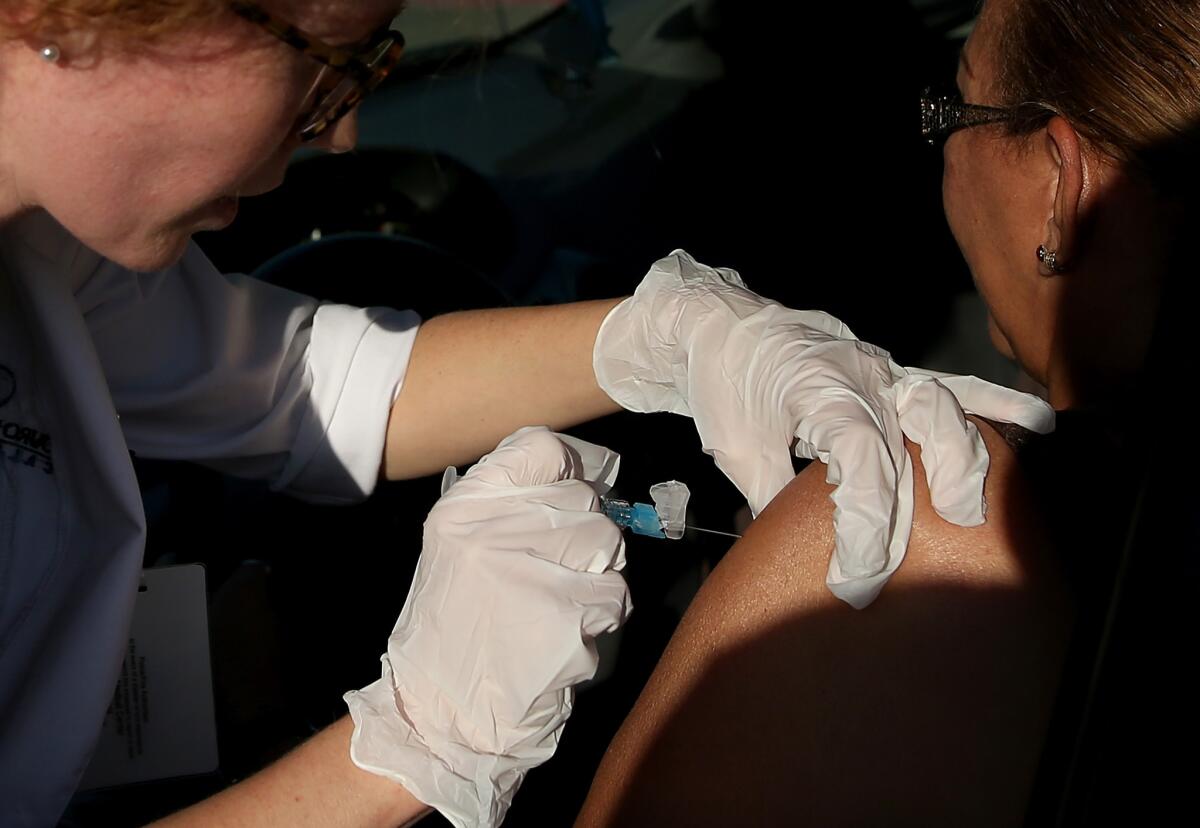California has so far gotten a break from the flu, and it might be helped by the weather

A flu vaccine is administered during a drive-through flu shot clinic at Doctors Medical Center in San Pablo, Calif., in November 2014.
- Share via
Two years ago, influenza killed 146 Californians between October and late January. When the flu season ended months later, more than 400 people had died of the infection — an outbreak the state rated “moderately severe.”
After a huge improvement last year — the season’s death toll plummeted to 78 — the situation looks even better now.
There have been just three flu-related deaths in California since October, and experts say the weather could be part of the reason.
Influenza spreads easiest in cold and dry conditions — and California has experienced a largely warm fall and winter, punctuated by heavy rains, especially in the northern part of the state.
Much of the rest of the country has also recorded unusually warm temperatures — the weekend’s massive blizzard notwithstanding — in part because of El Niño.
Last month was, on average, the country’s hottest and wettest December on record, according to the National Centers for Environmental Information. In other words, December’s weather created conditions least conducive to the spread of the flu.
As of mid-January, flu cases were minimal or low in 47 states, according to data released Friday by the Centers for Disease Control and Prevention. At the same time last year, activity was minimal or low in 17 states.
Helen Macfie, who monitors emergency room visits at Southern California’s six MemorialCare Hospitals, said few patients are showing up with the flu, even at Long Beach Memorial Medical Center, which runs one of the busiest ERs in Los Angeles County.
“We’re really seeing very little uptick so far, so mostly more common colds and those sorts of things,” she said. “Definitely slower than in prior years.”
Still, public health officials note that the state collects flu death data only on Californians younger than 65, so the death toll is likely much higher. They also warn that flu outbreaks are unpredictable and that the country could still be hit hard in the coming weeks. The flu season often peaks in February, though the last three seasons did so in December, said Lynnette Brammer, an epidemiologist for the CDC.
“We seem like we’re back on a more normal pattern actually,” she said. “Because recent ones were unusually early, it feels like this one is abnormal.”
She pointed to new CDC data that show flu activity going up from the first week of January to the second week. “It may peak in February, it may be a little bit later. I don’t know, but we’re definitely seeing a true increase in flu activity,” Brammer said.
Sadina Reynaldo, an epidemiologist with the Los Angeles County Department of Public Health, said large numbers of people probably aren’t falling sick from the flu because most of the strains circulating are the same as last year’s. That means that people who were infected last year still have some immunity against the virus.
In Los Angeles County, 456 people had tested positive for the flu as of two weeks ago, according to county data. By that time during last year’s flu season, there had been 1,405 flu diagnoses.
Join the conversation on Facebook >>
According to the CDC, people have been infected this season by H3N2, H1N1 and some B viruses. Though experts say H3 viruses can cause bad flu seasons, with more hospitalizations and deaths, researchers found that the strains circulating now match those included in the available vaccine — meaning that this year’s flu shot is probably providing strong immunity.
Reynaldo emphasized that everyone should be vaccinated against the flu, even if they are healthy and likely to recover quickly. “It’s not for you,” she said, “you don’t want to spread it to someone else who may not be so fortunate if they get sick.”
James Tamerius, a professor at the University of Iowa who studies how the environment affects human health, said this year’s mild season could be due to the warmer temperatures seen in December. “I don’t think it’s the sole reason, but it could be delaying it a bit,” he said.
Even as numerous Eastern states dig out from the effects of Winter Storm Jonas, forecasts show that the warmer weather will continue in many parts of the country. According to the National Weather Service Climate Prediction Center, a huge swath of the country — the northern half and the West Coast — will experience unusually warm temperatures into late April, largely because of El Niño.
Tamerius said that it was once believed that the flu was transmitted more in cold weather because people spent more time indoors in closer proximity, making it easier for germs to jump from person to person. However, there isn’t much scientific evidence to back that up, he said.
The accepted theory now is that the virus thrives in low humidity, and therefore is more likely to infect somebody who comes into contact with it, he said. It’s also possible that spending time in cold, dry air makes humans more susceptible to catching the virus, he said.
“There definitely seems to be a link,” he said.
Twitter: @skarlamangla
ALSO
What’s causing the rise in STDs in L.A. County and how can technology help?
‘My entire family is sick’ -- Porter Ranch residents describe how the leak has affected their lives
Southern California sushi restaurant chain cheated chefs and other staff on overtime, feds say
More to Read
Sign up for Essential California
The most important California stories and recommendations in your inbox every morning.
You may occasionally receive promotional content from the Los Angeles Times.











